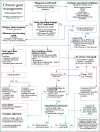Clinical pathways for primary care: current use, interest and perceived usability
- PMID: 29529203
- PMCID: PMC7647017
- DOI: 10.1093/jamia/ocy010
Clinical pathways for primary care: current use, interest and perceived usability
Erratum in
-
Erratum to: Clinical pathways for primary care: current use, interest and perceived usability.J Am Med Inform Assoc. 2018 Aug 1;25(8):1111. doi: 10.1093/jamia/ocy049. J Am Med Inform Assoc. 2018. PMID: 29846585 Free PMC article. No abstract available.
Abstract
Objective: Translating clinical evidence to daily practice remains a challenge and may improve with clinical pathways. We assessed interest in and usability of clinical pathways by primary care professionals.
Methods: An online survey was created. Interest in pathways for patient care and learning was assessed at start and finish. Participants completed baseline questions then pathway-associated question sets related to management of 2 chronic diseases. Perceived pathway usability was assessed using the system usability scale. Accuracy and confidence of answers was compared for baseline and pathway-assisted questions.
Results: Of 115 participants, 17.4% had used clinical pathways, the lowest of decision support tool types surveyed. Accuracy and confidence in answers significantly improved for all pathways. Interest in using pathways daily or weekly was above 75% for the respondents.
Conclusion: There is low utilization of, but high interest in, clinical pathways by primary care clinicians. Pathways improve accuracy and confidence in answering written clinical questions.
Figures



Similar articles
-
Personalized Digital Care Pathways Enable Enhanced Patient Management as Perceived by Health Care Professionals: Mixed-Methods Study.JMIR Hum Factors. 2025 May 15;12:e68581. doi: 10.2196/68581. JMIR Hum Factors. 2025. PMID: 40373224 Free PMC article.
-
Large-scale implementation of electronic Integrated Management of Childhood Illness (eIMCI) at the primary care level in Burkina Faso: a qualitative study on health worker perception of its medical content, usability and impact on antibiotic prescription and resistance.BMC Public Health. 2019 Apr 29;19(1):449. doi: 10.1186/s12889-019-6692-6. BMC Public Health. 2019. PMID: 31035968 Free PMC article.
-
[Chronic obstructive lung disease management programmes do not benefit the coordination of care pathways].Ugeskr Laeger. 2014 Sep 29;176(40):V04140244. Ugeskr Laeger. 2014. PMID: 25294515 Danish.
-
EHR-Integrated Clinical Pathways Promote Education, Confidence, and Save Time for Primary Care Providers.Am J Med Qual. 2022 Nov-Dec 01;37(6):528-534. doi: 10.1097/JMQ.0000000000000087. Epub 2022 Oct 14. Am J Med Qual. 2022. PMID: 36227103
-
Effects of Clinical Pathways for COPD on Patient, Professional, and Systems Outcomes: A Systematic Review.Chest. 2019 Nov;156(5):864-877. doi: 10.1016/j.chest.2019.04.131. Epub 2019 May 28. Chest. 2019. PMID: 31150639
Cited by
-
Clinical pathways and patient-related outcomes in hospital-based settings: a systematic review and meta-analysis of randomized controlled trials.Acta Biomed. 2021 Feb 9;92(1):e2021093. doi: 10.23750/abm.v92i1.10639. Acta Biomed. 2021. PMID: 33682818 Free PMC article.
-
Barriers to and facilitators of the implementation of multi-disciplinary care pathways in primary care: a systematic review.BMC Fam Pract. 2020 Jun 19;21(1):113. doi: 10.1186/s12875-020-01179-w. BMC Fam Pract. 2020. PMID: 32560697 Free PMC article.
-
Development and validity testing of a matrix to evaluate maturity of clinical pathways: a case study in Saskatchewan, Canada.BMC Health Serv Res. 2024 Jul 10;24(1):793. doi: 10.1186/s12913-024-11239-x. BMC Health Serv Res. 2024. PMID: 38982479 Free PMC article.
-
Towards a New System for the Assessment of the Quality in Care Pathways: An Overview of Systematic Reviews.Int J Environ Res Public Health. 2020 Nov 20;17(22):8634. doi: 10.3390/ijerph17228634. Int J Environ Res Public Health. 2020. PMID: 33233824 Free PMC article. Review.
-
A framework for clinical care pathway renewal: an example from inflammatory bowel disease.BMC Med Res Methodol. 2025 Jul 9;25(1):173. doi: 10.1186/s12874-025-02616-z. BMC Med Res Methodol. 2025. PMID: 40634845 Free PMC article.
References
-
- Korn L, Corrigan J, Donaldson M. To Err is Human: Building a Safer Health System. Washington: Institute of Medicine; 1999.
-
- Woolf SH. The meaning of translational research and why it matters. JAMA 2008; 2992:211–213. - PubMed
-
- Rotter T, Kinsman L, James E et al. . Clinical pathways: effects on professional practice, patient outcomes, length of stay and hospital costs. Cochrane Database Syst Rev 2010; 3:CD006632. - PubMed
MeSH terms
LinkOut - more resources
Full Text Sources
Other Literature Sources

